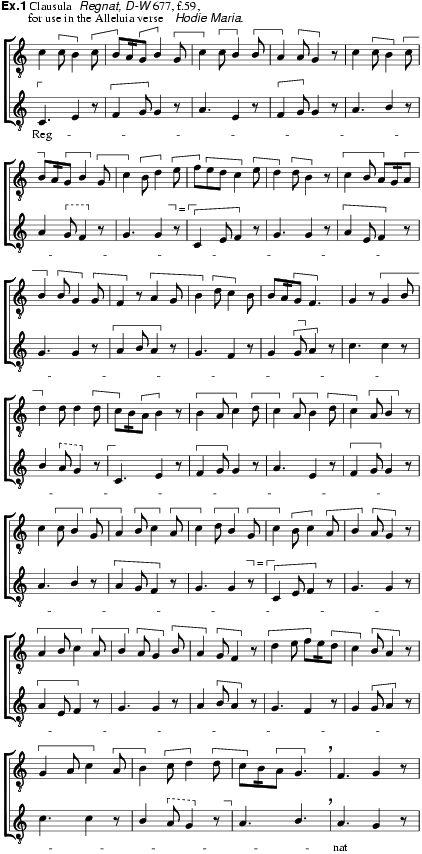
(Lat., from claudere: ‘to close’, ‘to conclude’).
A term used in medieval grammar and rhetoric in a number of senses, all denoting either the concluding of a passage, or the passage itself thus concluded. Its uses in medieval music theory apparently sprang from these, and occupy a similar range of meanings.
Throughout the 11th to 15th centuries the word ‘clausula’ may have had any of the following meanings, depending on the date of writing and the context: (1) a musical ending, in a general sense; (2) an ending specifically on the final of the mode (hence a close connection with the dual ideas of apertum–clausum (Lat.), ouvert–clos (Fr.), or half- and full close); (3) a specific melodic formula for use at a close; (4) a formal section within plainchant; (5) correspondingly, a section within a polyphonic setting of plainchant; (6) as a special case of the last, a polyphonic section that is marked out from its context by its use of a particular technique of composition.
All these senses are defined primarily by linear, melodic considerations, either directly so, or via the tenor that forms the basis of the polyphonic composition. Consequently, the notion of ‘cadence’, defined more in terms of harmony (or at least thought of as chords), came to form an antithesis to clausula from the early 16th century onwards. (Cadence is concerned with the total effect of the parts at a close. By contrast, the melodic formulae present in the individual voices at such a close are themselves the clausulas. Not until the 18th century was this distinction lost sight of, so that clausula too took on the sense of cadence.)
In its formal sense the word ‘clausula’ is reserved nowadays almost exclusively for its most important historical application, the clausula of the Notre Dame period. The musicians involved seem by nature to have been concerned not with creating new compositions but rather with taking up and developing an older practice. From the very beginnings of sacred polyphony, plainchant melodies were not always set in their entirety; often only certain sections were set polyphonically, the remainder being left monophonic. This practice became more common and was applied in a variety of ways.
First, and most important, only specific parts of the plainchant were set. Later, these parts, in an organum style that was not yet modally rhythmic, came to be replaced by new passages (specifically called ‘clausul sive puncta’) that used modal rhythm. At this stage, the contrast between monophonic and polyphonic sound that had hitherto been effective was supplanted by the contrast between different types of rhythm, resulting from different techniques of composition.
The chance combination of the clausula principle with modal rhythm was at its most powerfully influential on the revisions made to the two-voice settings in the Magnus liber which were carried out with the aim of modernizing its style. Hundreds of two-voice passages were composed for this work, and occasionally also for the three- and four-voice organum settings. Some were incorporated into later versions of the Magnus liber; others, placed in liturgical order, were assembled in special fascicles of the appropriate manuscripts, so that a clausula could easily be introduced into an organum setting, or into a piece of plainchant.
These clausulas thus became the most important area for experimentation in the compositional techniques of the day, especially for the development of discant. A great many of the cardinal principles of composition and methods of formal construction found in later music either came to fruition within clausulas or were foreshadowed by them: the melodic and formal implications of divisive rhythm, hocket, repetition of all kinds, phrase structure, imitation, retrogression, augmentation, diminution and so on (ex.1). Because of this, and also because of the practice of notating clausulas separately, there was a marked tendency for clausulas to increase in size and to become independent compositions. (The repeating of the tenor one or more times, which is necessary to achieve this expansion, lies at the roots of the later phenomenon of isorhythm.)

By the introduction of new texts (which often troped the tenor but rapidly broke free of this function) as underlay for the upper voices of these clausulas, many of the Notre Dame motets seemed to come into existence. The earlier hypothesis that the motet form was created in this way is now doubted, however. Such early motets served only for a very short time in the role of substitute section, quickly becoming independent compositions in their own right. They also superseded clausulas as the principal experimental form. The production of clausulas died out in the second half of the 13th century.
See also Discant; Motet, §I, 1; Organum; Rhythmic modes; Trope (i).
F. Racek: Die Clauseln von W1 (Codex Wolfenbüttel 677, früher Helmstad.628) (diss., U. of Vienna, 1939)
M.F. Bukofzer: ‘Interrelations between Conductus and Clausula’, AnnM, i (1953), 65–103
R. Jakoby: Untersuchungen über die Klausellehre in deutschen Musiktraktaten des 17. Jahrhunderts (diss., U. of Mainz, 1955)
D.D. Coulton: The Two-Part Clausulae of the MS Wolfenbüttel 677 (diss., Indiana U., 1956)
W.G. Waite: ‘The Abbreviation of the Magnus liber’, JAMS, xiv (1961), 147–58
N.E. Smith: The Clausulae of the Notre-Dame School: a Repertorial Study (diss., Yale U.,1964)
R. Flotzinger: Der Discantussatz im Magnus liber und seiner Nachfolge (Vienna, 1969)
G.A. Anderson: ‘Clausulae or Transcribed Motets in Florence Manuscripts?’, AcM, xlii (1970), 109–28
J. Stenzl: Die vierzig Clausulae der Handschrift Paris, Bibliothèque Nationale, Latin 15139 (Saint-Victor Clausulae) (Berne, 1970)
N.E. Smith: ‘From Clausula to Motet: Material for Further Studies in the Origin and Early History of the Motet’, MD, xxxiv (1980), 29–66
H. Tischler: ‘The Evolution of the Magnus Liber Organi’, MQ, lxx (1980), 163–74
W. Frobenius: ‘Zum genetischen Verhältnis zwischen Notre-Dame-Klauseln und ihren Motetten’, AMw, xlix (1987), 1–39
H. van der Werf: Integrated Directory of Organa, Clausulae, and Motets of the Thirteenth Century (Rochester, NY, 1989)
C. Dahlhaus: ‘Die maskierte Kadenz: zur Geschichte der Diskant-Tenor-Klausel’, Neue Musik und Tradition: Festschrift Rudolf Stephan, ed. J. Kuckertz and others (Laaber, 1990), 89–98
RUDOLF FLOTZINGER